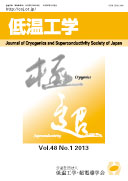All issues

Volume 48, Issue 3
Displaying 1-4 of 4 articles from this issue
- |<
- <
- 1
- >
- >|
Preface
-
Seiichi FUJIHIRA2013Volume 48Issue 3 Pages 109
Published: March 25, 2013
Released on J-STAGE: April 18, 2013
JOURNAL FREE ACCESSDownload PDF (599K)
Fundamental Cryogenic Engineering
-
—Novel Classes of High-Tc Superconductors—Jun AKIMITSU, Kazumasa HORIGANE2013Volume 48Issue 3 Pages 110-118
Published: March 25, 2013
Released on J-STAGE: April 18, 2013
JOURNAL FREE ACCESSWe review several novel classes of new superconductors discovered within the last 10 years: 1) graphite intercalated llerene superconductors, 3) diamond and wide-gap superconductors, 4) aromatic superconductors, 5) MgB2 superconductors, 6) layered nitride superconductors and 7) iron-based superconductors. Finally, we briefly comment perspective on higher-Tc superconductors.View full abstractDownload PDF (2139K)
Originals
-
Akihiro TSURUTA, Yutaka YOSHIDA, Yusuke ICHINO, Ataru ICHINOSE, Kaname ...2013Volume 48Issue 3 Pages 119-126
Published: March 25, 2013
Released on J-STAGE: April 18, 2013
JOURNAL FREE ACCESSThere has been a great deal of activity recently focused on REBa2Cu3Oy (REBCO) films with BaSnO3 (BSO) nanorods. It is known that BSO nanorods exert a strong pinning force on the flux line along the c-axis of REBCO. Previously, we fabricated non-stoichiometric Sm1.04Ba1.96Cu3Oy films with BSO nanorods. However, the superconducting properties and flux pinning properties of these films were inferior to those of BSO-doped YBCO films reported in the literature. In this study, we investigate the effect of the difference in Sm1+xBa2-xCu3Oy (SmBCO) composition ratio on the flux pinning force of BSO nanorods. We fabricated BSO-doped Sm1Ba2Cu3Oy film [SmBCO (x=0)] and BSO-doped Sm1.04Ba1.96Cu3Oy film [SmBCO (x=0.04)]. From TEM observations, the BSO nanorods in SmBCO (x=0) had grown parallel to the c-axis of SmBCO. In SmBCO (x=0.04), however, the BSO nanorods were angled. We measured the magnetic field dependence of Jc and then estimated Fp from Jc-B curves at 77 K in B//c. The FpMAX value of SmBCO (x=0) and SmBCO (x=0.04) reached 24.5 and 14.8 GN/m3, respectively. Thus, the pinning force of BSO nanorods in SmBCO (x=0) was stronger than that of SmBCO (x=0.04). These results indicate that the composition ratio of SmBCO affects the growth of BSO nanorods in BSO-doped SmBCO films, and that the shape of BSO nanorods has an influence on the superconducting properties of SmBCO film in a magnetic field.View full abstractDownload PDF (981K) -
Shin OHNO, Masashi AKITA, Daisuke MIYAGI, Makoto TSUDA, Takataro HAMA ...2013Volume 48Issue 3 Pages 127-132
Published: March 25, 2013
Released on J-STAGE: April 18, 2013
JOURNAL FREE ACCESSResearch and demonstrations of the near-future use of high-temperature superconducting (HTS) cable as a transmission power cable has been conducted in many countries. Our study focused on a HTS tri-axial cable composed of three concentric phases. A tri-axial cable is more advantageous than a co-axial cable that is composed of three cores in one cryostat. Since conventional tri-axial cables have not realized three-phase equilibrium, we proposed a tri-axial cable composed of two longitudinal sections with different twist pitches. The characteristics of the balanced tri-axial cable were not clear, so we studied AC loss and fault current behavior of the balanced model. On the other hand, there have been no reports of the analysis of heat transfer for the balanced tri-axial cable in steady state operation. The steady state analysis is important for operating a HTS cable for a long time stably and for optimization of the cable structure. In this paper, we analyzed the temperature distribution in the balanced tri-axial cable using a finite difference method. AC losses and fluid characteristics were considered in this analysis. Since a tri-axial cable has two LN2 channels, we considered four types of cooling methods that have different LN2 streams and locations of refrigerators. In the LN2 stream, parallel flow and counter flow were adopted in this analysis. We investigated the cooling characteristics of an HTS tri-axial cable considering heat transfer and fluid properties.View full abstractDownload PDF (1587K)
- |<
- <
- 1
- >
- >|